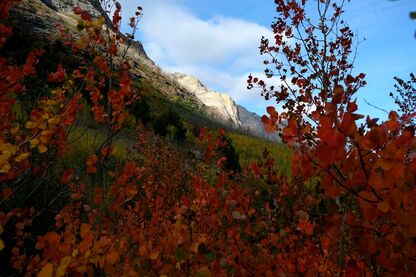 The Aspens in the Ruby Mountains in Eastern Nevada have already taken on various shades of yellow, orange, and red! The Aspens in the Ruby Mountains in Eastern Nevada have already taken on various shades of yellow, orange, and red! We’re answering the age old question today: why do leaves turn orange, yellow, and red in the fall? Most people know that it has something to do with chlorophyll and seems to correspond with trees losing their leaves for winter. And all those things are true, but let’s break down the whole process. Leaves have chlorophyll, a green-blue pigment; that’s what makes leaves green and that’s what allows plants to photosynthesize. But leaves also contain lots of other pigments, like keratinoids (orange/brown) and xanthophylls (blue/purple/red). The relative proportions of these other pigments determines how leaves change color in the fall. Some species (and even some individuals or populations of a given species) have high concentrations of carotenoids, and in the fall they turn yellow or orange and then brown and fall off. Other species (or individuals) have higher concentrations of xanthophylls and turn that brilliant red or even purple. Aspens are a great example of the chemical variation between individuals and populations. The aspens in Galena Creek turn a fiery orange in autumn; aspens in other areas turn yellow, and other populations even turn red! The nutritional composition of the soil and the specific genetics of a population will determine autumn colors. So, take your friends out to Galena Creek in mid-October to see the beautiful aspens, and make sure you drop the word “xanthophyll” in conversation!
0 Comments
Leave a Reply. |
AuthorThis blog is managed by the staff and volunteers of Galena Creek Visitor Center. We write about parts of the natural world that we find fascinating and want to teach others about, as well as keeping you updated on the Visitor Center and park. If you want to learn more, please sign up for our monthly newsletter, where we share upcoming events, updates on the ecology of the park, and highlights from each month. Archives
October 2021
Categories |
 RSS Feed
RSS Feed
